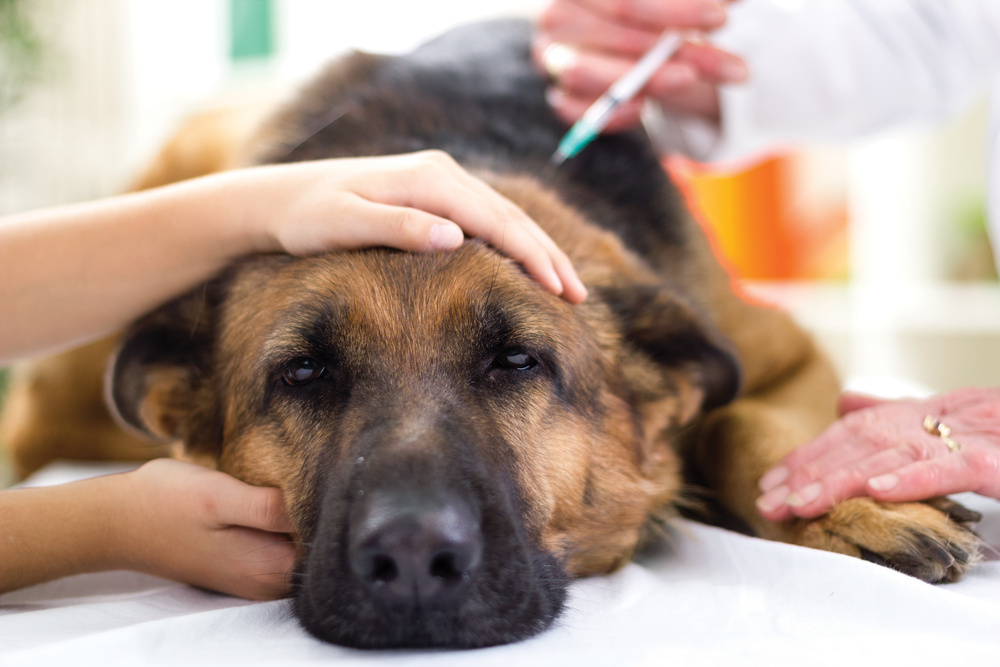Protecting Your Pet from Common, Dangerous Toxins

Unfortunately, pets can occasionally become ill, and sometimes die, from toxin exposure. While most intoxications are accidental, some cases result from inappropriate treatment by well-meaning owners who are unaware that dogs and cats may react differently to medications intended for human use. In rare instances, poisoning may be malicious. Often, owners know or suspect their pet has been exposed to a toxic substance; however, in instances where owners are unaware, a sudden onset of dramatic clinical signs in a previously healthy pet should cause concern.
Common pet poisons
Each year, the ASPCA Animal Poison Control Center (APCC) compiles a list of the most common toxins pets encounter. Knowing what substances pets frequently get into can help you keep your furry friend safe.
For dogs, human medications top the list, followed by pesticides, fertilizers, and other yard and garden products; plants and wild mushrooms; veterinary medications; and cleaning and household maintenance products, including rodenticides.
For cats, human medications are also the most common, followed by veterinary medications; poisonous plants; pesticides, fertilizers and other yard and garden products; cleaning and maintenance products, including rodenticides; and dietary supplements.
- Human medications — The drugs intended for human use reflect the most commonly prescribed medications for pain (e.g., ibuprofen), mental disorders (e.g., tranquilizers, sedatives and bi-polar medications), and cardiovascular disease (e.g., blood pressure medications), which underlines the need to store human medications in a pet-proof location. Acetaminophen (i.e., Tylenol) is not well metabolized by dogs and can be lethal in cats, so should never be given to relieve pain. Further, inappropriate veterinary drug use—for example, using canine flea products in cats—can prove deadly.
- Household products — Always follow label directions for common household pesticides and cleaning agents to prevent inadvertent pet exposure. Keep in mind that feline grooming behavior makes it likely that cats will consume contaminants on their hair coat. Ethylene glycol, the toxic chemical in antifreeze, can attract both dogs and cats; however, toxicity is less common as safer alternatives are used.
- Toxic foods — Dogs and cats should be prevented from eating three main food categories:
- Chocolate — All forms are toxic, but dark and baker’s chocolate contain higher toxin concentrations, and are extremely toxic.
- Grapes — Fresh and dried forms (e.g., raisins, currants, and sultanas) can cause sudden kidney failure in dogs and cats, so extreme caution is required.
- Xylitol — This artificial sweetener, found in toothpaste, mouthwash, some peanut butter products, and sugar-free gum, candy, mints, pudding, and Jello, can induce fatal hypoglycemia and liver failure in pets.
- Toxic plants— Many plants can cause toxicity, so exercise care when selecting house plants and decorative flowers. All lilies are extremely toxic to cats, and consumption of small amounts can cause fatal kidney failure. Some wild mushrooms are extremely toxic, and any ingestion constitutes a medical emergency.
Common toxicity signs in pets
Clinical toxicosis signs vary widely depending on the toxin. For example, caustic substances cause oral inflammation, excessive salivation, and severe vomiting and diarrhea. Human and veterinary medications often cause exaggerated effects, such as extreme tranquilization, tremors, and seizures. Acetaminophen (i.e., Tylenol) induces blue mucous membranes (i.e., cyanosis) and shortness of breath. Your intimate knowledge of your pet’s normal behavior provides the most sensitive indicator that something is wrong.
Caring for poisoned pets
The key to successful toxicity management is early intervention to reduce exposure. If you believe your pet has been exposed to a toxin, identify the plant or toxic substance from the product container, or take a photograph of the item, and call Bayside Animal Hospital, or the ASPCA Animal Poison Control Center for further recommendations. Prior to bringing your pet in for evaluation, we may advise first aid, such as:
- Flushing the area — If your pet chewed or ingested an irritant, we may ask you to flush your pet’s mouth with tap water for 10 to 15 minutes using a turkey baster, while ensuring your pet’s nose is pointed down to prevent water inhalation.
- Inducing vomiting — We may direct you to induce vomiting to quickly eliminate a toxin and prevent absorption. Never induce vomiting without veterinary guidance, as some toxins can cause more damage as they are vomited, and vomiting cannot be safely induced in cats at home.
- Applying a skin protectant — For topical contamination with a corrosive or caustic substance, the affected area should be thoroughly rinsed with water while wearing gloves, a sterile lubricant (e.g., KY® Jelly) applied, and the area covered with a loose bandage.
Diagnosing pet toxicity
In many instances, owners are aware their pet has been exposed to a toxin—for example, they were observed eating chocolate, swallowing a pill, or chewing on a houseplant. However, owners may be aware only that their pet suddenly became ill. While our veterinary team’s physical exam and diagnostic tests can help elucidate the cause, knowing your home environment is essential for an accurate diagnosis.
Treating pet toxicity
Toxicity treatment includes preventing further toxin absorption, helping the pet eliminate toxin that has been absorbed, and administering supportive treatments. Specific treatment depends on the toxin your pet was exposed to, and may include:
- Inducing vomiting or pumping a pet’s somach to limit toxin absorption
- Administering activated charcoal to prevent toxin absorption
- Administering intravenous fluids
- Providing drugs to protect the liver
- Administering medications to control clinical signs, such as vomiting or seizures
- Administering an antidote, if available
Most often, success is dependent on early intervention.
You may take every precaution to keep your pet out of harm’s way, but some toxins are so tempting to pets, they still get themselves into trouble. If that happens, contact us immediately at Bayside Animal Hospital—we are here to help.


